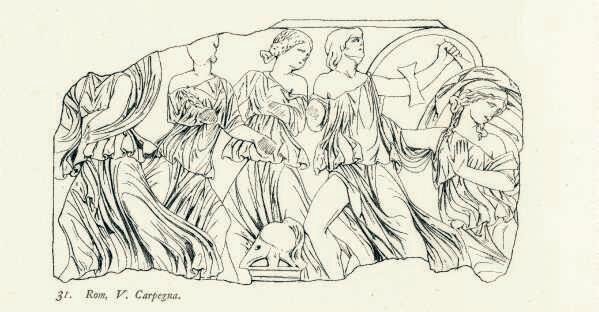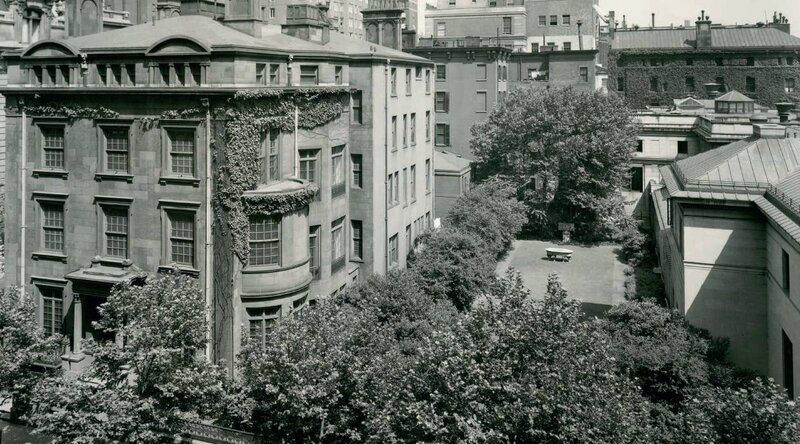A Roman marble panel from a sarcophagus, circa 180 A.D.
Lot 66. A Roman marble panel from a sarcophagus, circa 180 A.D. Estimate $70,000 - $90,000. Price Realized $317,000. Photo Christie's Image Ltd 2016.
Sculpted in high relief, depicting Achilles on Skyros, the hero at the center, lunging to the left with his head turned back, dressed as a woman, wearing a chiton falling off his right shoulder, holding a circular shield in his raised left hand, his crested Corinthian helmet on the ground before him, one of the daughters of King Lycomedes collapsing to the right, probably Deidamia, with three of her sisters fleeing to the left, each wearing long diaphanous belted tunics, that to the left with a billowing mantle arching over her head, the right edge restored with a bearded warrior charging to the left, holding a shield and a sword; the back of the panel ornamented with a complex guilloche pattern from its re-use in late antiquity as a chancel screen; 57 1/8 in. (145 cm.) long
Provenance: Palazzo della Valle, Rome, 1584.
Villa Carpegna, Rome.
Prospero Sarti, Rome.
with L. Pollak, Rome, 1906.
with A. Marcocchia, Rome, 1907.
Pierpont Morgan (1837-1913), New York.
Literature: G. Zoega, Li bassirilievi antichi de Roma, incise da Tommaso Piroli, Rome, 1808, App. Fol. 410d.
O. Jahn, Archäologische Beiträge, Berlin, 1847, p. 353.
J.A. Overbeck, Bildwerke zum thebischen und troischen Heldenkreis, Stuttgart, 1857, p. 289, no. 7.
F. Matz and F. von Duhn, Antike Bildwerke in Rom mit Ausschluss der grösseren Sammlungen, Leipzig, 1881-1882, p. 451, no. 3347.
C. Robert, Die Antiken Sarkophag-Reliefs, Band II, Berlin, 1890, p. 47, no. 31; Band III 2, 1904, p. 222, n. I; Band III 3, 1919, p. 548.
L. Pollak, Collezione Prospero Sarti, Rome, 1906, no. 18, pl. 5.
F. Brommer, Denkmälerlisten zur griechischen Heldensage, vol. 2, Marburg, 1974, p. 82, no. 14.
D. Kemp-Lindemann, Darstellungen des Achilleus in griechischer und römischer Kunst, Bern and Frankfurt am Main, 1975, p. 65, no. 165.
G. Koch, “Verschollene mythologische Sarkophage, Ein archäologischer Steckbrief,” in Archäologischer Anzeiger, 1976, p. 103, no. 2, n. 2.
A. Kossatz-Deissmann, “Achilleus,” in Lexicon Iconographicum Mythologia Classicae, vol. I, Zurich and Munich,1981, p. 64, no. 163.
G. Koch and H. Sichtermann, Römische Sarkophage, Munich, 1982, p. 128, n. 14, p. 129, n. 26.
D. Grassinger, Die Mythologischen Sarkophage, Erster Teil, Ahill, Adonis, Aeneas, Aktaion, Alkestis, Amazonen, Berlin, 1999, no. 9, pl. 4,4.
From C. Robert, Die Antiken Sarkophag – Reliefs, Band II, 1890.
The relief seen on the eastern side of the garden once belonging to Pierpont Morgan, on Madison Avenue between 36th and 37th streets.
This sculpture was a focal point on the eastern side of the greensward in the the lovely garden designed by Beatrix Farrand for Pierpont Morgan. Believed to have been removed in the mid-1950s, it was stored since at the Morgan Library & Museum. It draws its subject from Homer’s Iliad, which famously revolves around the exploits of Achilles, the greatest of the Greek heroes who fought in the Trojan war. While the narrative is expansive in volume and scope, its time span is limited to a few weeks in the latter part of the war, stopping short before the death of the hero at the hand of Paris. Similarly, Homer omits tales of the hero’s earlier life from his wartime epic. In the 1st century A.D. the Roman poet Statius took upon the task of detailing the hero’s life from birth until death in his Achilleid, no doubt based on earlier Greek authors, but he died after only having completed one and a half books, which mostly recount the hero’s youth. One portion of the partially finished text is the colorful tale of how Achilles entered into the Trojan War. Statius relates that it was prophesized that Achilles would die at Troy, and thus his mother Thetis sent him to the court of King Lycomedes on the island of Skyros, where he would live disguised as a woman among the King's daughters. Achilles fell in love with one of them, Deidamia, with whom he fathered Neoptolemus and Oneiros. Since another prophecy suggested that the Trojan War would not be won without Achilles, Odysseus and his companions set out to find him. Odysseus offered gifts to the King's daughters, including adornments, musical instruments and weapons. Achilles was tricked into revealing himself when Odysseus' men sounded a war trumpet, for the hero could not resist the call to arms and immediately grabbed a shield and helmet. The scene depicted on the sarcophagus fragment presented here is the moment of his discovery on Skyros.
Christie's. ANTIQUITIES, 12 April 2016, New York, Rockefeller Plaza

/https%3A%2F%2Fprofilepics.canalblog.com%2Fprofilepics%2F1%2F0%2F100183.jpg)
/https%3A%2F%2Fstorage.canalblog.com%2F03%2F02%2F119589%2F96711876_o.jpg)
/https%3A%2F%2Fstorage.canalblog.com%2F11%2F31%2F119589%2F94773502_o.jpg)
/https%3A%2F%2Fstorage.canalblog.com%2F20%2F83%2F119589%2F94772815_o.jpg)
/https%3A%2F%2Fstorage.canalblog.com%2F26%2F72%2F119589%2F75604929_o.jpg)
/https%3A%2F%2Fstorage.canalblog.com%2F59%2F60%2F119589%2F26458628_o.jpg)






/http%3A%2F%2Fstorage.canalblog.com%2F49%2F93%2F119589%2F129358692_o.jpg)
/http%3A%2F%2Fstorage.canalblog.com%2F04%2F31%2F119589%2F127173660_o.jpg)
/http%3A%2F%2Fstorage.canalblog.com%2F20%2F86%2F119589%2F120616936_o.jpg)
/http%3A%2F%2Fstorage.canalblog.com%2F22%2F29%2F119589%2F120579983_o.jpg)